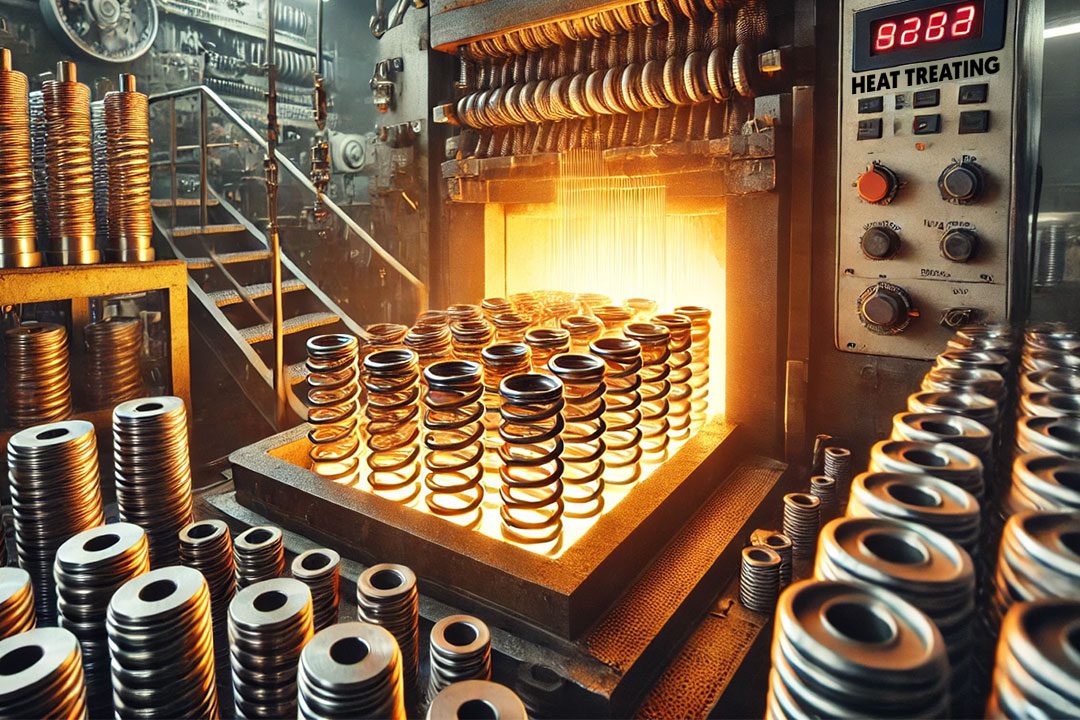Stress relieving is a heat treatment process applied to metal springs and wire forms to remove internal stresses that develop during the manufacturing process.
This treatment enhances the performance, stability, and longevity of springs by preventing premature failure and ensuring they retain their designed mechanical properties under operational loads.
At Western Spring Manufacturing, stress-relieving treatments are integral to the production of high-quality springs. By carefully applying precise heat treatment processes, Western Spring ensures that custom springs perform reliably across various industries, meeting stringent durability and performance standards.
To learn more about how precision coil springs are manufactured, visit our article on The Art of Crafting Precision Coil Springs and Wire Forms.
Stress Relieving Process and Grades
Stress relieving typically involves heating springs or wire forms to a specific temperature range—usually between 300°F and 1,200°F (depending on the material)—and holding them at that temperature for a designated period. The treatment is followed by controlled cooling to relieve internal stresses without affecting the overall hardness or strength of the material.
This treatment is applied to various grades of materials, including:
- High-carbon steel: Used for music wire, where stress relieving ensures consistency in elasticity and tensile strength.
- Stainless steel: Stress relieving is critical in maintaining corrosion resistance and mechanical integrity.
- Alloy steels: Such as chrome silicon and chrome vanadium, which benefit from stress-relieving treatments to enhance performance in high-stress applications.
For more on selecting the appropriate spring materials, visit Choosing the Right Spring Materials for Optimal Performance and Longevity.
Stress Relieving Properties and Characteristics
Key properties and characteristics of stress-relieved springs include:
- Improved Fatigue Resistance: Stress relieving helps increase the number of load cycles a spring can endure without failure.
- Dimensional Stability: Reduces the risk of deformation and ensures springs maintain their intended shape under load.
- Enhanced Tensile Strength: For materials like music wire or alloy steel, stress relieving helps maintain tensile strength while improving elasticity.
- Surface Hardness: Stress relieving can optimize hardness depending on the material grade and the specific treatment temperature.
Mechanical properties affected by stress relieving include:
- Modulus of Elasticity (E): 29,000,000–30,000,000 psi for carbon and alloy steels.
- Modulus of Rigidity (G): 11,000,000–11,500,000 psi.
- Tensile Strength: Varies depending on the material, typically ranging from 200,000 to 400,000 psi for carbon steels.
Stress relieving can improve performance in springs made from a variety of materials. However, for stainless steel and alloy steels, the process must be carefully controlled to avoid compromising corrosion resistance or other beneficial properties.
Spring and Wire Form Applications
Stress-relieving treatment is widely used across various spring types and wire forms, including:
- Compression Springs
- Counter Balance Springs
- Clock Springs
- Die Springs
- Extension Springs
- Flat Springs
- Torsion Springs
Stress-relieved springs are vital in multiple industries:
- Aerospace: For high-reliability components like control systems.
- Agriculture: Enhances the lifespan of springs in heavy-duty equipment.
- Automotive: Ensures durability in suspension and engine systems.
- Defense: Used in highly reliable mechanisms for military equipment.
- Industrial: Increases fatigue life in machinery and tools.
- Medical: Ensures precise performance in medical devices.
Explore the applications of springs across industries in our article From Automotive to Aerospace: Applications of Springs in Different Industries.
Advantages and Limitations of Stress Relieving
Advantages:
- Reduces internal stresses, minimizing the risk of premature failure.
- Improves dimensional stability and consistency across load cycles.
- Increases fatigue resistance, prolonging the operational life of springs.
- Enhances mechanical properties without significantly altering the material’s hardness.
Limitations:
- While stress relieving improves fatigue life, it does not prevent corrosion, especially for materials like carbon steel.
- For stainless steels, improper stress relieving can reduce corrosion resistance.
Stress Relieving Compared with Other Treatments
Stress relieving is distinct from annealing, a process that fully softens the material to increase malleability, while stress relieving primarily reduces internal stresses without significant changes in hardness. Compared to other treatments like tempering, stress relieving offers more specific control over residual stresses without compromising mechanical properties.
Future Trends and Innovations
Emerging trends in heat treatment technology are making stress-relieving processes more efficient and precise, particularly for high-performance applications. Innovations in automation allow for more consistent results in complex manufacturing environments.
In the future, advances in alloy materials that retain their mechanical properties at higher temperatures could expand the applications of stress-relieved springs in extreme environments. Discover more about how automation is influencing manufacturing in our article How Automation is Affecting the Future of Spring Manufacturing.

